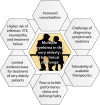Multiple myeloma in the very elderly patient: challenges and solutions
- PMID: 27143866
- PMCID: PMC4839967
- DOI: 10.2147/CIA.S89465
Multiple myeloma in the very elderly patient: challenges and solutions
Abstract
Diagnosis and management of myeloma in the very elderly patient is challenging. Treatment options have vastly improved for elderly myeloma patients but still require the clinician to personalize therapy. In this paper, we offer evidence-based, pragmatic advice on how to overcome six of the main challenges likely to arise: 1) diagnosis of myeloma in this age group, 2) assessment of the need for treatment, and the fitness for combination chemotherapy, 3) provision of the best quality of supportive care, 4) choice of combination chemotherapy in those fit enough for it, 5) treatment of relapsed myeloma, and 6) provision of end of life care. With an increased burden of comorbidities and a reduced resilience to treatment and its associated toxicities, the management of myeloma in this age group requires a different approach to that in younger patients to maximize both quality and length of life.
Keywords: diagnosis; elderly; myeloma; treatment.
Figures


References
-
- Altekruse SF, Kosary CL, Krapcho M, et al. SEER Cancer Statistics Review, 1975–2007. Bethesda, MD: National Cancer Institute; 2010. [Accessed February 4, 2016]. Available from: http://seer.cancer.gov/csr/1975_2007/index.html.
-
- Palumbo A, Bringhen S, Ludwig H, et al. Personalized therapy in multiple myeloma according to patient age and vulnerability: a report of the European Myeloma Network (EMN) Blood. 2011;118(17):4519–4529. - PubMed
-
- Schaapveld M, Visser O, Siesling S, Schaar CG, Zweegman S, Vellenga E. Improved survival among younger but not among older patients with Multiple Myeloma in the Netherlands, a population-based study since 1989. Eur J Cancer. 2010;46(1):160–169. - PubMed
Publication types
MeSH terms
Grants and funding
LinkOut - more resources
Full Text Sources
Other Literature Sources
Medical

